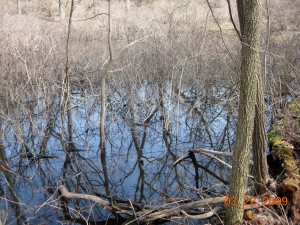Spring began in southwest Michigan in the past few days. One sign has been the Sandhill Cranes overhead, giving their loud rattle. They could be on their way north or they could be local birds; several pairs now nest in Kalamazoo County.
Because snow cover was so continuous, and thick, some birds that are usually here by February were mostly delayed into early March. The cranes are one species, Red-winged Blackbirds are another. I saw my first redwing a few days ago and they’re now pretty well scattered over the countryside.
In Pavilion Township Saturday, Song Sparrows were singing, Horned Larks were on territory in the open fields, and sailing overhead was my first Turkey Vulture of the new year. First in Michigan anyway; we saw Turkey and Black Vultures every day in Costa Rica. Most were probably resident there, but some could have been wintering birds from North America. This morning I saw my second Turkey Vulture sailing above West Main in Oshtemo Township.
I haven’t heard any frogs calling yet, and chilly as it is I don’t expect any tonight, but warmer weather is predicted for tomorrow.
As soon as bare patches began to appear around houses, the early spring bulbs were visible, some flowering. I’ve already seen winter aconite, snow drops, and crocuses in bloom without hunting very hard. Our native early spring wildflowers grow mostly in the mesic deciduous forests, and many of them are spring ephemerals–they come up, bloom, and then die back, so for most of the year they’re invisible above ground. Right now the beech-maple forests probably have harbinger-of-spring in flower, and in the wooded low spots currently occupied by temporary vernal pools, skunk cabbage flowers will be out, though perhaps not producing pollen quite yet.

Acute-leaved hepatica, an early spring wild flower, but not a spring ephemeral. Photographed in an Oshtemo Township oak forest by Richard Brewer.
Our native early spring flowers take advantage of the brief window of full sun that opens between the arrival of warmer weather and the closing of the forest canopy by sugar maples. It would make sense that the cultivated spring bulbs we buy and plant might be the early spring flowers from the deciduous forests of other parts of the Earth, but that isn’t the case. Rather, most of the spring bulbs blooming in our front yards come from the steppes or the alpine and sub-alpine meadows of the Middle East and Asia.
The seasons follow one another in a continuous cycle. A year has no natural beginning and no end. Several groups of ancients gave the winter solstice, around December 21, special significance because it was the day they were reassured that the sun was actually coming back for another year. Our New Year’s Day, January 1 is arbitrary but since it comes not too long after the solstice, it’s not wholly unsatisfactory as a starting point in the cycle.
To me, though, the first definite signs of spring in nature, the sorts of things that have happened in the past week or so, feel like the engine of the year starting up. In our temperate latitudes, this is the start of the year’s organic production; photosynthesis really gets underway, storing sunlight that, passed on along the food chain, runs nearly the totality of the living world. For a high percentage of the creatures here, spring is the time for beginning reproduction as well as production. Eggs hatch and babies are born, and young of the year having new combinations of genes not quite the same as either parent go out to become part of a later generation–or not.
Spring has arrived in southwest Michigan–I think–and a new year has started. Happy New Year!

Pingback: Kalamazoo County Spring 2010, Second Installment | Richard Brewer